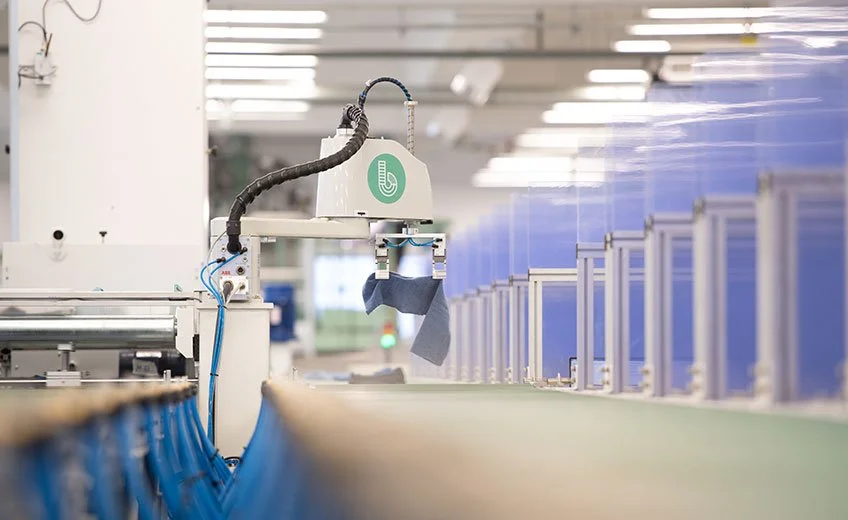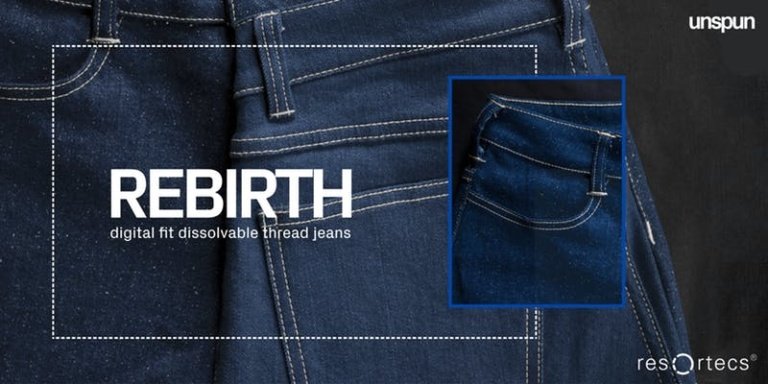Design for Recyclability Guide
Design for Recyclability Guide
Created by Redress
WhaT is it?
Recyclability takes responsibility for the end-of-life of products by considering recycling solutions and how they will impact certain product features. Designing for recyclability is a strategy that ensures products never become “waste”, but instead allows for closed-loop material recovery.
Why Do it?
When designers create with recyclability in mind, garments can be prepared for the eventual day when they no longer serve their initial purpose. Allowing materials to reincarnate in new forms diverts them away from the landfill.
Repairing, redistributing, redesigning and remanufacturing can minimise resource consumption by keeping garments in a smaller loop within the circular model [1]. Only as a last resort at the end of a garment’s life should it rejoin the bigger loop via recycling, which uses more resources. Designing for recyclability from the beginning ensures this final step can be taken with minimal hassle.
Right now, less than 1% of material used to produce clothing is recycled into new clothing at the end of its life [2] — but creators have the power to change that. Designing for recyclability not only benefits the environment, but may also give a financial edge to the brand and designer. With today’s take-make-use-dispose model leading to an economic value loss of over US$500 billion per year, fashion professionals have the opportunity to replace this linear system with a circular one [3].
How To do it?
The ultimate goal is a closed loop system that infinitely maintains the value and quality of all materials. It is all the better if garment fibres can be reused as yarn for garments, as opposed to recovering the material for lesser value products such as wipes or insulation, a process known as downcycling. To achieve a closed-loop system, creators need to be intentional in their design choices, from fibre selection, to material processing, garment construction, and labelling.
The recycling process is not as straightforward as it might sound. Collecting and sorting textiles is a major issue in the process, as waste textiles need to meet the quantitative and qualitative requirements of raw materials for industrial recycling. Recycling holds great potential in environmental benefits, but only if high recovery rates and quality products are achieved. It can be laborious and complicated, but with the right design decisions, clothing recyclability can be achieved. To understand this, we need to look into the different recycling methods.
1 How are textile products recycled?
Recycling can be sorted into a few methods: mechanical, hydrothermal, biological, chemical, and physical.
1.1 Mechanical Recycling
Mechanical recycling is currently the most used and scaled way of recycling. It involves the use of mechanical processes (cutting, shredding, carding) to process the fibres. During this process, the materials are sorted, trims (buttons, zippers, etc), or even plastic prints, are removed manually, and then the textile materials are processed into new yarns.
It aims to keep the nature of fibres intact, although fibres are shortened, and therefore lose quality. To reach a good quality recycled yarn with mechanical recycling, a small amount of virgin fibres need to be added to the recycled fibres when spinning the new yarn.
The recycling rate is higher for textiles made of a single fibre type, as blended textiles are not ideal for recycling. Although possible, the resulting material will still be a blend of fibres, which makes them less commercially desirable due to their lower recyclability. Designers are therefore encouraged to use monofibre materials.
Example: The Billie [4], G2G [5] and Looop [6] Recycling Systems

Image credit: The Billie System, Novotex
The Billie System was developed by Novotex Textiles Limited in Hong Kong. Its patented waterless six-step recycling process is almost entirely automated. It is a fully scaled system, able to process up to three tonnes of recycled fibres per day. The Billie System has received many awards and international recognition since its launch in 2019.

Image credit: HKRITA
The Garment-to-Garment (G2G) Recycling System was developed by the Hong Kong Research Institute of Textiles and Apparel (HKRITA). The original system is operated in The Mills, Hong Kong as a mini-mill version of the full scale plant setup, fitting in a 40-foot container. Mirroring the six-step recycling process of The Billie System, it also has two additional steps that enable the entire system to spin yarns and produce garments using a Whole Garment knitting machine (also known as a 3D knitting machine). Since its launch in 2018, the G2G System has garnered many international accolades.

Image credit: H&M
H&M launched Looop in 2020 in Stockholm, Sweden with HKRITA’s G2G Recycling System, making it the world’s first in-store recycling system. The installation showcased to consumers a glimpse of fashion’s future but also acted as a reminder that all clothes are a valuable resource — a powerful way to educate consumers about recyclability and circular fashion.
1.2 Hydrothermal Recycling
Hydrothermal recycling involves the use of water at high temperature, green chemicals, and pressure to allow for the separation of cellulosic-synthetic fibre blends. Different levels of temperature, pressure, or treatment time will result in various different products.
This process selectively decomposes the cellulose fibres into powder, while leaving the synthetic fibres intact. It can also remove dyestuff from the synthetic fibres. The separated fibres can then be respun into new synthetic fibre yarns, while the cellulose powder can be reused in new products (such as super-absorbency materials), creating a circular system.
Example: The Green Machine [7]


Images credit: HKRITA & H&M Foundation
The Green Machine is a pre-industrial scale hydrothermal system developed in collaboration by HKRITA and H&M Foundation [8]. The system has been set up to recycle cotton-polyester blends using only heat, water, and less than 5% of a biodegradable green chemical. The outcome of the recycling process is a recovery rate of over 98% for polyester fibres in 0.5–2 hours, and the creation of cellulose-based powder.
1.3 Biological recycling
Biological recycling usually involves the use of enzyme treatment or fermentation methods to allow for the separation of cellulosic-synthetic fibre blends. This process selectively decomposes one of the fibre types, separating the blend and leaving the other fibre type suitable for re-spinning.
Biological recycling is still a nascent technology and thus may be limited in many supply chains.
Example: Carbios [9], HKRITA [10]

Image credit: Carbios
Carbios has developed proprietary enzymes with the ability to break down certain polyesters, in particular PET (most common in textiles) and PLA (a bio-based polymer). Their optimised enzymes are now used in two innovative processes: enzymatic recycling and the production of biodegradable plastics.

Image credit: HKRITA
HKRITA has developed a biological recycling process to separate polyester-cotton blended materials. It uses enzymes that degrade natural fibres into glucose, leaving the highly pure polyester fibres suitable for re-spinning.
1.4 Chemical recycling
Chemical recycling involves a dissolution treatment process to allow for the separation of cellulosic-synthetic fibre blends.
Sustainable chemicals are used to dissolve organic materials - selectively transforming the synthetic fibres into a solution, while leaving the cellulose fibres intact [11]. This process can also remove dyestuff from the cellulosic fibres. The separated fibres can then be respun into new cellulosic yarns.
Chemical recycling is still a nascent technology and thus may be limited in many supply chains.
Example: Worn Again [12]

Image credit: Worn Again
UK-based organisation Worn Again uses advanced chemical recycling technology that recaptures raw materials from non-reusable products. Their advanced recycling technology is able to separate, decontaminate, and extract polyester and cellulose (from cotton) from non-reusable textiles and polyester bottles and packaging to produce dual PET and cellulose outputs. They launched their pilot in January 2020 and in early 2021 reported being close to building their first full-scale plant.
1.5 Physical recycling (for synthetic fibres)
Physical recycling is specific to synthetic fibres (plastics). The recycling process consists of shredding and melting the polyester fibres to create pellets of plastic that are melt-spun into new synthetic filaments.
1.6 Regeneration (for cellulosic fibres)
Regeneration of cellulosic fibres is an alternative way to recycle cellulose into a new material. Cellulose of any form (fibres but also pulp) is dissolved in a bath of sustainable chemicals and then submitted to solution-spinning to form a new filament. The resulting fibre is an artificial (man-made) fibre such as lyocell.

Image credit: NuCycl
Evrnu’s NuCycl is made from cotton rich textiles. NuCycl is a technology that converts pre- and post-consumer, as well as post-industrial textile waste materials, into a new lyocell fibre material.
What about biodegradability?
Biodegradability is the ability of materials to be decomposed by bacteria or other living organisms (e.g. fungi), which avoids pollution. It is often discussed as an alternative approach for the end-of-life of garments.
When considering biodegradability, the first important parameter is to make sure the fibres in question have the property to be biodegradable. This includes cellulosic fibres (e.g. cotton, hemp, abaca, lyocell), animal fibres (e.g. wool, silk), or some bioplastics engineered to be biodegradable. The second parameter, as equally important, is to consider the treatment of the fibres. Most fibres in the textile industry are chemically treated. This means that even fibres that were originally biodegradable may biodegrade less quickly, or worse, release harmful chemicals into the environment.
Biodegradability can contribute to the closed-loop system of a circular economy (biological loop), but it also means the precious resources that went into creating textile products are not recovered, which is not ideal.
2 How to approach design for recyclability?
With such varying capacities of different recycling methods, it is clear that recyclability is highly impacted by how garments are designed. Realistically, mechanical recycling is the most widespread, yet it also has its limitations. Consider this blueprint of designing for recyclability based specifically on mechanical recycling.
2.1 Fibre selection
Here are some considerations regarding the fibre selection:
- Blended fibres are not ideal for recycling in the current context of industrial recycling processes, since their output will still be blended, which is not commercially viable for fashion brands.
- Unfortunately, a lot of products are made from three to four different fibre types, which might prevent their recyclability.
- Elastane fibres are particularly challenging for recycling. As such, discarded jeans containing elastane mostly end up as insulation or industrial wipes.
- Worn out fibres with reduced strength and shorter length are also challenging for mechanical recycling. Designers are recommended to choose good quality materials from the beginning.
The following design recommendations will improve the recyclability of products:
- Choose fabrics made from monofibres or a lower number of fibre types, given it does not affect the lifespan or performance of the product.
- Avoid design features that may prevent the recycling process. For example, membrane structures and padding may easily block cards. Film prints and laminations may completely block the carding process.
- Understand the material and current recycling limitations.
Recycled ≠ Recyclable
Recycled or regenerated fibres are an interesting sourcing choice when it comes to ending the reliance on virgin materials. However, recycled or regenerated materials, or materials containing such fibres, are not necessarily easily recyclable. No matter which source of fibres a product is made of (virgin, recycled, or regenerated), the same considerations around recyclability apply.
2.2 Fabric processing
Here are some considerations regarding fabric processing:
- The presence of chemicals and hazardous substances can come from colour dyes and finishings, such as water repellent coatings, glues, or anti-bacterial treatment.
- Chemicals can disturb recycling processes and must be tracked, traced, and removed for cost and energy-efficient handling.
The following design recommendations will improve the recyclability of products:
- Being toxic-free is a common prerequisite for the production of a valuable secondary raw material.
- Designers should check with suppliers to verify whether they use additives and dyestuffs that could lead to recycling problems.
2.3 Design and Construction
Design features like the number of components used and choice of fastening methods influence the ease of a garment’s disassembly for recycling.
Stitching thread fibres should match the fibre content of the fabric, especially if the product is using a monofibre material.
Adopting innovative dissolvable stitches can be an interesting strategy to recover entire pattern pieces and consider remanufacturing instead of recycling.
Example: Resortecs and unspun’s collaboration [14]

Image credit: unspun
Hong Kong based denim brand unspun [15] developed a pair of jeans using Resortecs’ [16] dissolvable stitching threads. Through a bespoke takeback programme, unspun is able to recover the fabric and the trims of worn denim jeans and use the materials to remanufacture new products.
Trims and accessories need to be removed manually during the recycling process, which is laborious and time-consuming. Minimising use of these decorative elements can ease garment disassembly.
Bondings, heat transfers, and silicone prints are not recyclable, and must therefore be removed manually through cutting around them before the remaining fabric gets processed. In some cases, they may prevent the garment’s recyclability entirely, so are best avoided.
2.4 Labelling
Once all the design decisions are made, they need to be communicated accurately so that consumers and recycling facilities know how to handle a product at the end of its life.
Recycling technology relies on correct labelling and material identification. Depending on the product and based on legislation, only 95–98% of the fibre content must be declared on the label. Unfortunately, incorrect and insufficient labelling is prevalent.
Accurate labelling is vital for future recycling, so designers should be fully transparent on their labels. It is all the better to go beyond what regulations require by detailing the name and type for every component, including textiles, threads, and trims, as well as their production.
2.5 Closing the loop
Getting acquainted with local recycling solutions and partners to gauge what recycling options are available can help guide certain design decisions.
Prioritising local recycling is also better for the environment since this can minimise the carbon footprint of transportation. Designers can support consumers by providing information about their local recycling programmes, by giving guidance online and in-store, and by partnering with local organisations to ensure recycling when garments reach their end-of-life.
Footnotes
[1] Redress (2022). Circularity in Fashion
https://www.redressdesignaward.com
[2] House of Commons: Environmental Audit Committee (2019), Fixing Fashion: Clothing Consumption and Sustainability
https://publications.parliament.uk/
[3] Ellen MacArthur Foundation (2017), A New Textiles Economy: Redesigning Fashion's Future.
https://www.ellenmacarthurfoundation.org/
[4] The Billie (n.d.) | https://thebillieupcycling.com/
[5] HKRITA (2022), G2G garment recycling system Phase II
https://www.hkrita.com/en/our-innovation-tech/
[6] H&M (2020), From old to new with Looop
https://www2.hm.com/en_gb/life/culture/
[7] HKRITA (n.d.), Post-consumer Blended Textile Separation and Recycling by Hydrothermal Treatment
https://www.hkrita.com/en/our-innovation-tech
[8] H&M Foundation (n.d.), Green Machine - recycling blend textiles at scale.
https://hmfoundation.com/project
[9] Carbios (n.d.), Enzymatic recycling: removing the constraints of current processes
https://www.carbios.com/en/enzymatic-recycling/
[10] HKRITA (n.d.), Textile Waste Recycling by Biological Method
https://www.hkrita.com/en/our-innovation-tech
[11] Yousef, Samy & Tatariants, Maksym & Tichonovas, Martynas & Sarwar, Zahid & Jonuškienė, Ilona & Kliucininkas, Linas. (2019). A new strategy for using textile waste as a sustainable source of recovered cotton. Resources, Conservation and Recycling.
https://www.researchgate.net/publication
[12] Worn Again Technologies (n.d.) | https://wornagain.co.uk/
[13] NuCycl (n.d.), | https://nucycl.com/
[14] The Mills Fabric (n.d.), When Dissolvable Thread Meets Customized Jeans: One Step Closer to Closing the Loop
https://www.themillsfabrica.com/insights/blogs/
[15] Unspun (n.d.), | https://unspun.io/
[16] Resortecs (n.d.), | https://resortecs.com/






